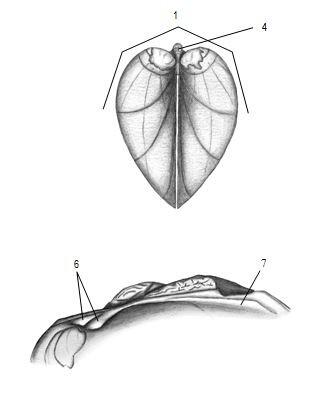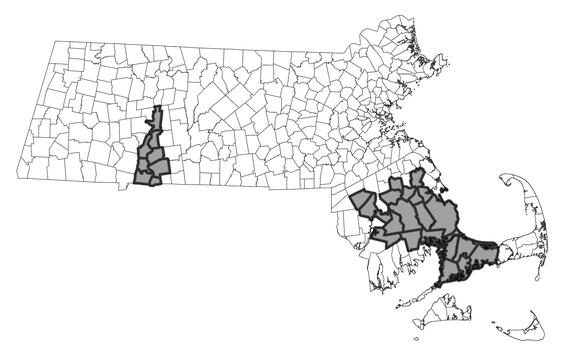- Scientific name: Atlanticoncha ochracea
- Species of Greatest Conservation Need (MA State Wildlife Action Plan)
- Special Concern (MA Endangered Species Act)
Description
Tidewater mucket
The tidewater mucket is a medium-sized mussel that rarely exceeds 100 mm (4 in) in length. The shape is ovate, and the shells are laterally inflated (1). Shells of sexually mature females are usually more rounded toward the posterior ventral margin (2) and thus more oval-shaped than males or adolescent females. Shells are uniformly thin but quite strong. The beaks (3) are prominent and raised above the hinge line (4), and the hinge itself (5) is also quite prominent. Hinge teeth are thin and delicate. The left valve has two pseudocardinal teeth and two lateral teeth, and the right valve has two pseudocardinal teeth (6) and one lateral tooth (7). Pseudocardinal teeth are rather thin and elongate (compared to the stout triangular teeth of some other species) and are located anterior of the beak. The periostracum (8) is usually yellowish or greenish-brown, sometimes with a bronze or reddish hue. Juveniles tend to be more yellowish, but their shells darken with age. Fine green rays (9) are usually evident on the shell, especially in younger specimens. Dark interannular lines (10) may also be evident on clean shells. The nacre (11) is usually pinkish or salmon-colored.
It is often very difficult to distinguish this species from the yellow lampmussel. Compared to the yellow lampmussel, the tidewater mucket is smaller, it has a thinner shell, and it has more delicate hinge teeth. Its shell is not nearly as shiny or yellow as the shell of the yellow lampmussel, and the tidewater mucket has dark interannular lines (10) on the periostracum. The nacre of the tidewater mucket is usually pinkish or salmon-colored, whereas it is white or bluish-white in the yellow lampmussel. Other differences are described in Nedeau et al. 2000 and Nedeau 2008. The only places currently known in Massachusetts where these two species overlap are in the Connecticut River. Live tidewater muckets can sometimes be confused with eastern lampmussels (a more common species), especially if they have dark or eroded shells, and an expert should be consulted for accurate identification.


Illustrations by Ethan Nedeau.
Life cycle and behavior
Tidewater muckets are essentially sedentary filter feeders that spend most of their lives partially burrowed into the bottoms of rivers, streams, lakes, and ponds. Like all freshwater mussels, larvae (called glochidia) of the tidewater mucket must attach to the gills or fins of a vertebrate host to develop into juveniles. Wick (2003) found that white perch was a suitable host for the tidewater mucket. The suitability of alewife as a host for tidewater muckets was also tested, but all fish perished before results were apparent. Kneeland and Rhymer (2008) found that the banded killifish was a potential host for tidewater muckets in Maine, based on the observation of one fish that was infested with 21 glochidia. The white perch and banded killifish are each tolerant of brackish conditions and prefer the same types of habitats as tidewater muckets. The potential role of alewife as a host fish for the tidewater mucket should be further investigated. Also, the striped bass is closely related to the white perch (in the genus Morone) and its recent resurgence in the lower Connecticut River might be related to a recent perceived recovery of tidewater muckets in this same area.
Distribution and abundance
The tidewater mucket is found in Atlantic coastal drainages from Georgia to Nova Scotia. In Massachusetts, the species is found in the Middle Connecticut, Taunton, and Cape Cod watersheds. Most occurrences are from coastal plain ponds in southeastern Massachusetts and Cape Cod. Although this species occurs throughout the lower Connecticut River in Connecticut, it has only been found in a very limited area of the river in Massachusetts (Nedeau 2008).
The tidewater mucket is listed as a species of Special Concern in Massachusetts. Some coastal plain ponds in Massachusetts support remarkably high densities of tidewater muckets with evidence of successful reproduction, whereas many others have smaller populations with animals in poor condition. The viability of the population in the Massachusetts portion of the Connecticut River watershed is uncertain and here the species is considerably more imperiled. Surveys and a careful status review are needed.

Distribution in Massachusetts.
1999-2024
Based on records in the Natural Heritage Database.
Habitat
The tidewater mucket, as its name suggests, inhabits coastal freshwater environments. It occurs in small to large rivers, ponds, and lakes that have, or historically had, direct unimpeded connections with coastal waters. In the Connecticut River watershed, it inhabits muddy, sandy, and gravelly substrates. They have been found in water depths of one to more than 25 feet, and in a variety of flow conditions, but seem to prefer depositional areas with slow currents. Coastal plain ponds of southeastern Massachusetts with springtime alewife runs may provide the best habitat for this species with sandy to gravelly substrates.
Healthy habitats are vital for supporting native wildlife and plants. Explore habitats and learn about conservation and restoration in Massachusetts.
Large river habitat typical for tidewater mucket.
Threats
Because tidewater muckets are essentially sedentary filter feeders, they are unable to flee from degraded environments and are vulnerable to the alterations of water bodies. Tidewater muckets occur in lakes and rivers, and the threats in these two habitats are different. Overlapping threats include nutrient enrichment, sedimentation, other forms of pollution, non-native and invasive species, and the many consequences of urbanization. River populations of tidewater muckets are threatened by alteration of natural flow regimes, encroachment of river corridors by development, habitat fragmentation caused by dams, and a legacy of land use that has greatly altered the natural dynamics of river corridors (Nedeau 2008). Lake populations are challenged by intense development, modification and recreational use of sensitive shoreline habitats, accelerated eutrophication, and more frequent cyanobacteria blooms. Dams and other stream barriers in the rivers that connect lakes to coastal waters may also affect lake populations of tidewater muckets. Invasive plants and animals, such as European milfoil and basket clam (Corbicula fluminea), are having severe impacts on the fragile ecology of coastal plain ponds. The ultimate consequences on tidewater muckets and other native species are not completely known, but the prognosis is bleak. In addition, the long-term effects of regional or global problems such as acidic precipitation, mercury, and climate change are considered severe but little empirical data relates these stressors to mussel populations. In combination with the above stressors (e.g., water withdrawals, eutrophication), effects from climate change including sustained droughts and warmer water temperatures, threaten tidewater mucket populations by reducing water levels, and creating more suitable conditions for cyanobacteria blooms particularly in lentic systems that have shown to cause mussel kills.
Freshwater mussel tracks in exposed substrate as a result of low water levels caused by prolonged drought and water withdrawal.
Conservation
Survey and monitoring
Standardized surveys are critically needed to monitor known populations, evaluate habitat, locate new populations, and assess population viability at various spatial scales (e.g., stream, watershed, state). Survey efforts should continue to search for new populations via physical and potentially eDNA surveys, particularly in coastal watersheds, and expand our knowledge on the species distribution in extant watersheds every 5 years or the extent feasible. Establishment of long-term monitoring sites in extant watersheds are needed to acquire critical demographic and population trend data. Monitoring these sites should occur annually in multi-year blocks or as needed.
Management
Discovery and protection of viable mussel populations is critical for the long-term conservation of freshwater mussels. Currently, much of the available mussel occurrence data are the result of limited presence/absence surveys. In addition, regulatory protection under MESA only applies to rare species occurrences that are less than 25 years old. Surveys are critically needed to monitor known populations, evaluate habitat, locate new populations, and assess population viability so that conservation and restoration efforts, as well as regulatory protection, can be effectively targeted. Coastal plain ponds are critical to the long-term viability of the tidewater mucket in Massachusetts, and these habitats are also experiencing intense development pressure and recreational use. Understanding this threat and developing conservation and management strategies is a high priority for NHESP. Other conservation and management recommendations include: understand the effects of shoreline development and recreational use of lakeshores; maintain naturally variable river flow and lake water levels and limit water withdrawals; identify, mitigate, or eliminate sources of pollution to waterbodies including accelerated eutrophication in coastal plain ponds; addressing the problems of combined sewer overflows and the other effects of urban, industrial, and agricultural runoff is critical for protecting and restoring the tidewater mucket in the Connecticut River watershed; identify dispersal barriers for host fish, especially those that fragment the species range within a river or watershed, and seek options to improve fish passage or remove the barrier; maintain adequate vegetated riparian buffer along rivers and lakes; protect or acquire land at high priority sites.
Research needs
Research needs for tidewater mucket include population-level data on survival rate, mortality rate, individual growth rates, population size trends, age at reproduction, sex ratio, and age structure. These data will help develop population viability models to identify when populations may need active restoration. A better understanding of host fish relationships is needed; this information might help guide fisheries management at the fishways. Habitat mapping of large rivers can aid in evaluation of suitable physical habitat and direct future survey effort. Climate change projections for water temperature and water levels in occupied and potential watersheds for species introduction are also needed to assess current and future population risks to drought and cyanobacteria blooms and identify potential refuges. Investigation of impacts of invasive species, particularly basket clam (Corbicula fluminea), on tidewater mucket is needed. Additionally, species-specific physiological tolerances to commonly used and novel herbicides are needed.
References
Kneeland, S.K., and J.M. Rhymer. 2008. Determination of fish host use by wild populations of rare freshwater mussels using a molecular identification key to identify glochidia. Journal of the North American Benthological Society 27(1): 150-160.
Lefevre, G., and W.C. Curtis. 1911. Metamorphosis without parasitism in the Unionidae. Science 33: 863-865.
Nedeau, E.J. 2008. Freshwater Mussels and the Connecticut River Watershed. Connecticut River Watershed Council, Greenfield, Massachusetts. xviii+ 132 pp.
Nedeau, E.J., and J. Victoria. 2003. A Field Guide to the Freshwater Mussels of Connecticut. Connecticut Department of Environmental Protection, Hartford, CT.
Nedeau, E.J., M.A. McCollough, and B.I. Swartz. 2000. The Freshwater Mussels of Maine. Maine Department of Inland Fisheries and Wildlife, Augusta, Maine.
Raithel, C.J., and R.H. Hartenstine. 2006. The Status of Freshwater Mussels in Rhode Island. Northeastern Naturalist 13(1): 103-116.
Vaughn, C. 1993. Can biogeographic models be used to predict the persistence of mussel populations in rivers? pp.117-122 in K.S Cummings, A.C. Buchanan and L.M. Koch (eds)., Conservation and Management of Freshwater Mussels: proceedings of a UMRCC symposium, 12-14 October 1992, St. Louis, Missouri. Upper Mississippi River Cons. Com., Rock Island, Illinois. 189 pp.
Wick, P.C. 2003. Fish hosts and demographics of Lampsilis cariosa and Leptodea ochracea, two threatened freshwater mussels in Maine. M.S. Thesis, University of Maine, Orono, Maine.
Contact
| Date published: | March 28, 2025 |
|---|